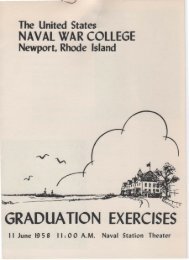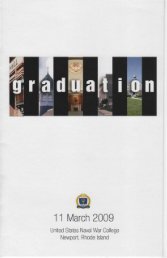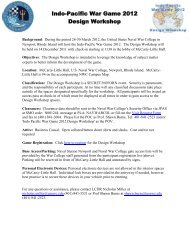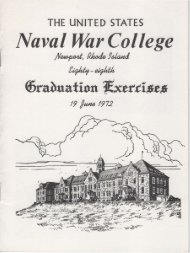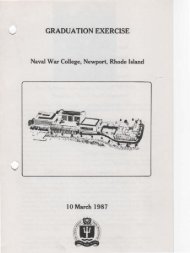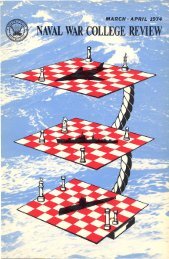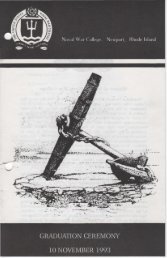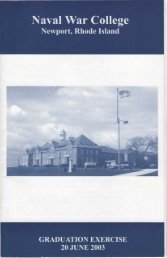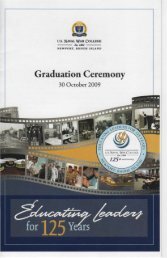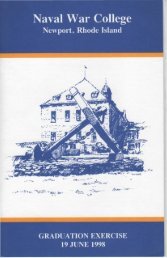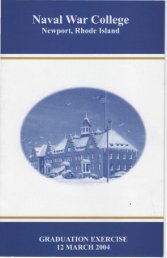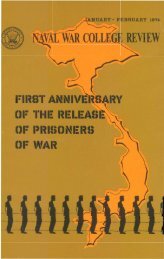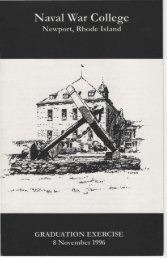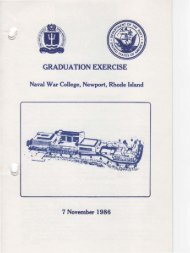February 3, 2010 - US Naval War College
February 3, 2010 - US Naval War College
February 3, 2010 - US Naval War College
You also want an ePaper? Increase the reach of your titles
YUMPU automatically turns print PDFs into web optimized ePapers that Google loves.
U.S. NAVAL WAR COLLEGE<br />
--- Est. /884 ---<br />
NEWPORT, RHODE ISLAND<br />
Graduation Ceremony<br />
3 <strong>February</strong> <strong>2010</strong>
HISTORY OF THE U.S. NAVAL WAR COLLEGE<br />
Founded in Newport, Rhode Island, on October 6, 1884, the <strong>Naval</strong> <strong>War</strong><br />
CoUege is the oldest war coUege in the nation, and the first military service<br />
institution in the world to be designated a war college. Commodore<br />
Stephen B. Luce was the first president and organized the <strong>War</strong> CoUege as<br />
"a place of original research on all questions relating to war and the<br />
statesmanship connected with war, or the prevention of war." These<br />
foundations were built upon by Captain Alfred Thayer Mahan, second<br />
president of the CoUege, who had originally been selected by Luce to<br />
initiate the course in aval History. Of all the men who were to influence<br />
the institution in its early years, none was to have a more profound impact.<br />
Mahan's views deeply affected such leaders as Henry Cabot Lodge and<br />
Theodore Roosevelt and through them and others helped shape the<br />
United States' destiny at the turn of the century. Mahan's writings,<br />
published as The Illfluence of Seapower Upon History, 1660-1783, gained<br />
him worldwide acclaim and established the <strong>Naval</strong> <strong>War</strong> <strong>College</strong> as an<br />
internationally respected institution.<br />
Functioning continuously since 1884, except for brief periods during<br />
the Spanish-American <strong>War</strong> and World <strong>War</strong> I, the <strong>War</strong> CoUege numbers<br />
among its graduates such distinguished naval officers as Admirals Sims,<br />
Spmance, King, Nimitz, and Halsey, in addition to many others who today<br />
are holding prominent military positions.<br />
The work begun more than one hundred years ago by Luce and Mahan<br />
continues today. As graduates well know, the curriculum is both demanding<br />
and rewarding. For the military professional, the unique education provided<br />
by the <strong>Naval</strong> <strong>War</strong> <strong>College</strong> is unrivaled. In recognition of the academic<br />
rigor and educational excellence of its program, the <strong>Naval</strong> <strong>War</strong><br />
<strong>College</strong> was accredited in 1991 by the New England Association of Schools<br />
and <strong>College</strong>s to award a Master of Arts Degree in National Security and<br />
Strategic Studies.
THE ACADEMIC PROCESSION AND REGALIA<br />
For centuries, institutions of higher learning have dignified their<br />
ceremonies with an academic procession, a custom descending from the<br />
clerical procession. The procession is led by a marshal, followed by the<br />
student body and the academicians or faculty, attired in the robes prescribed<br />
for their respective degrees. Distinguished visitors and delegates follow the<br />
faculty, and last in the procession comes the president of the institution.<br />
Each member of an academic procession ordinarily wears a cap, gown,<br />
and hood. In the procession today military faculty will not wear academic<br />
gowns. The earliest illustration of gowns worn at Oxford University<br />
somewhat resembles cassocks worn by English teachers who found good use<br />
for the hood, or cowl, as protection against the weather. A uniform<br />
American system of academic heraldry displays the level of degree, the field<br />
of study in which it was earned, and the institution by which it was granted.<br />
It is the hood which provides academic regalia its color and offers the most<br />
information about its wearer. The silk lining of the hood bears the color, or<br />
colors, of the degree-granting college or university; its velvet facing reveals the<br />
color assigned to each area of study. The Bachelor's gown is relatively simple,<br />
falling in straight lines from an elaborate yoke and having pointed sleeves. The<br />
Master's gown is slightly more elaborate and fastens about the wrist. The<br />
Doctor's gown is marked by velvet panels down the front and around the<br />
neck, as well as by three bars of the same material on the well-shaped sleeves.<br />
It is cut more fully and may be ornamented. The hood worn is three feet in<br />
length for Bachelors, three and one-half feet for Masters, and four feet for<br />
Doctorates, with velvet trimming of two, three, and five inches in width<br />
respectively.<br />
The edging, or facing, velvet of academic hoods indicates the area of study.<br />
The principal scholarly fields seen in the procession today include:<br />
Philosophy<br />
Arts, Letters, Humanities<br />
Business Administration<br />
Economics<br />
Engineering<br />
Law<br />
International Affairs/Public Administration<br />
Dark Blue<br />
White<br />
Light Brown<br />
Copper<br />
Orange<br />
Purple<br />
PeacockJ3lue<br />
The American mortarboard, derived from the soft Oxford cap, is black.<br />
Its tassel, for holders of the bachelor's and master's degree, is usually black,<br />
while gold tassels are worn by holders of doctoral degrees and heads of<br />
institutions. The tassel is worn on the right side of the cap by<br />
undergraduates, on the left by holders of bachelor's and higher degrees.
PROGRAM<br />
Master of Ceremonies<br />
Captain Sharon B. Campbell, U.S. Navy<br />
Dean of Students<br />
Procession of Students<br />
Arrival of Official Party>!-<br />
Sung by Mrs. Julie Zecher<br />
Introduction<br />
Graduation Address<br />
Dr. Marc A. Genest<br />
Forrest Sherman Chair of Public Diplomacy, Strategy<br />
and Policy Department, and Co-Director of the<br />
Center on Irregular <strong>War</strong>fare and Armed Groups (CIWAG)<br />
Presentation of Diplomas<br />
Charge to Graduates<br />
Rear Admiral James P. "Phil" Wisecup, U.S. Navy<br />
President, U.S. <strong>Naval</strong> <strong>War</strong> <strong>College</strong><br />
National Anthem>!<br />
Invocation>!-<br />
Benediction>!-<br />
"Guests please stand
Rear Admiral James P. "Phil" Wisecup<br />
President, U.S. <strong>Naval</strong> <strong>War</strong> <strong>College</strong><br />
Rear Admiral James 'Phil' Wisecup became the<br />
52nd president of the U.S. <strong>Naval</strong> <strong>War</strong> <strong>College</strong> on<br />
Nov. 6, 2008. He most recently served as commander,<br />
Carrier Strike Group 7 (Ronald Reagan<br />
Strike Group), returning from deployment in<br />
October 2008.<br />
A 1977 graduate of the U.S. <strong>Naval</strong> Academy,<br />
Wisecup earned his master's degree in international<br />
relations from the University of Southern<br />
California, graduated from the <strong>Naval</strong> <strong>War</strong> <strong>College</strong><br />
in 1998, and also earned a degree from the University of Strasbourg, France, as an<br />
Olmsted Scholar, in 1982.<br />
At sea, he served as executive officer of<strong>US</strong>S Valley Forge (CG 50) during Operation<br />
Desert Storm. As commanding officer, <strong>US</strong>S Callaghan (DDG 994), he was<br />
awarded the Vice Admiral James Stockdale Award for Inspirational Leadership.<br />
He served as commander, Destroyer Squadron 21 during Operation Endurillg<br />
Freedom after 9/l1.<br />
Ashore, Wisecup was assigned to NATO Headquarters in Brussels, Belgium,<br />
served as force planner and ship scheduler for Commander, U.S. <strong>Naval</strong> Surface<br />
Forces, Pacific, and served as action officer for Navy Headquarters Plans/Policy<br />
Staff. He served as a fellow on the Chief of <strong>Naval</strong> Operations Strategic Studies<br />
Group; director, White Honse Situation Room and commander, U.S. <strong>Naval</strong><br />
Forces Korea.<br />
Wisecup's awards include the Defense Superior Service Medal, Legion of<br />
Merit, Bronze Star, and various unit, service and canlpaign awards.
Dr. Marc A. Genest<br />
Forrest Sherman Chair of Public Diplomacy,<br />
Strategy and Policy Department, and<br />
Co-Director of the Center on Irregular<br />
<strong>War</strong>fare and Armed Groups (CIW AG)<br />
Dr. Marc A. Genest holds the Forrest Sherman<br />
Chair of Public Diplomacy in the Strategy and<br />
Policy Department and is Co-Director of the<br />
Center on Irregular <strong>War</strong>fare and Armed Groups<br />
(CIWAG) at the <strong>Naval</strong> <strong>War</strong> <strong>College</strong> in Newport,<br />
RI. He is also the Area Study Coordinator for the<br />
Insurgency and Terrorism electives program. In<br />
2009, Genest received the Commander's Award for Civilian Service from the<br />
Department of the Army for outstanding service as a Special Advisor to the<br />
Commander of Task Force Mountain <strong>War</strong>rior while stationed in the eastern regional<br />
command of Afghanistan. Dr. Genest earned his Ph.D. from Georgetown<br />
University in International Politics. Before coming to the <strong>Naval</strong> <strong>War</strong> <strong>College</strong> Professor<br />
Genest taught at Georgetown University, the U.S. Air <strong>War</strong> <strong>College</strong> and the<br />
University of Rhode Island. While at the University of Rhode Island, Professor<br />
Genest received the University's Teaching Excellence Award. He also serves as a<br />
political commentator for local radio and news stations as well as for RI and national<br />
print media. In addition, Dr. Genest worked on Capitol Hill for Senator<br />
John Chafee and Representative Claudine Schneider. Dr. Genest has received fellowships<br />
and grants from numerous organizations including the United States<br />
Institute of Peace, the Arms Control and Disarmament Agency, the Harry S.<br />
Truman Foundation, the Foundation for the Defense of Democracy, Smith<br />
Richardson Foundation and the Bradley Foundation. Professor Genest's books<br />
include Negotiatillg ill the Public Eye: The Impact of the Press 011 the llltermediate<br />
Range Nuclear Force Negotiations, Conflict and Cooperation: Evolvillg Theories oj<br />
1l1temativnal Relations and Stand! Contending Issues ill World Politics. He has also<br />
written articles dealin'gwith international relations theory, strategic communication,<br />
American foreign policy and public opinion.
Ambassador Mary Ann Peters (ret.)<br />
Provost, U.S. <strong>Naval</strong> <strong>War</strong> <strong>College</strong><br />
Ambassador Peters became the fourth Provost<br />
of the <strong>Naval</strong> <strong>War</strong> <strong>College</strong> on 18 September 2008.<br />
Previously, she held the position of Dean of Academics<br />
of the <strong>College</strong> of International and SeClIrity<br />
Studies at the George C. Marshall European<br />
Center for Security Studies in Garmisch<br />
Partenkirchen, Germany. Prior to becoming the<br />
Dean of the <strong>College</strong>, Ambassador Peters served as<br />
Associate Director for International Liaison at the<br />
Marshall Center.<br />
Before joining the Marshall Center in 2003, Ambassador Peters spent more<br />
than 30 years as a career diplomat with the U.S. Department of State. From 2000<br />
to 2003 Ambassador Peters served as the U.S. Ambassador to Bangladesh, leading<br />
the Mission's efforts in support of the war on terrorism and other key U.S. foreign<br />
policy goa ls. She received a Presidential Meritorious Service Award in 2003 for her<br />
work in Bangladesh. Prior to her posting in Dhaka, Ambassador Peters was the<br />
Deputy Chief of Mission at the United States Embassy in Ottawa, Canada, responsible<br />
for the management of the Embassy and supervision of the six U.S.<br />
Consulates General in Canada.<br />
From 1995 to 1997, Ambassador Peters served in the White House as Director<br />
for European and Canadian Affairs at the National Security Council. Among<br />
other portfolios in this position, Ambassador Peters worked on the diplomatic<br />
and security aspects of the search for peace in Northern Ireland. From 1993 to<br />
1994, Ambassador Peters served as Deputy Assistant Secretary of State with oversight<br />
responsibility for U.S. relations with 19 Western European countries and<br />
Canada. In this capacity she acted as the U.S. Chair of the U.S.-Canada military<br />
coordination body, the Permanent Joint Board on Defense.<br />
A senior diplomat, fluent in six foreign languages, Ambassador Peters has also<br />
served in Sofia, Bulgaria, as Deputy Chief of Mission; in Moscow as Economic<br />
Counselor; and in Mandalay, Burma, as Principal Officer. Prior to her assignment<br />
in Moscow, she studied Russian at the U.S. Army Russian Institute in Garmisch,<br />
Germany. From 1988 to 1990, Ambassador Peters was the Deputy Director of the<br />
Office of Pakistan, Afghanistan and Bangladesh Affairs in the U.S. State Department.<br />
She began ber career as a Vice-Consul in Frankfurt in 1975.<br />
Ambassador Peters holds a Bachelor of Arts degree from Santa Clara University<br />
and a Masters in International Studies from the School of Advanced International<br />
Studies at The Johns Hopkins University. Her formal education also<br />
included course work in Paris, France, and Bologna, Italy.
COLLEGE OF NAVAL COMMAND AND STAFF<br />
Lieutenant Commander Derek J. Atkinson, U.S. Navy<br />
Lieutenant Jessica F. Betz, U.S. Navy<br />
Lieutenant Commander Christopher M. Biggs, U.S. Navy<br />
Lieutenant Commander Carl W. Brobst Jr., U.S. Navy<br />
Lieutenant Commander Scott T. Brown, U.S. Navy<br />
Lieutenant Commander Jason G. Butler, U.S. Navy<br />
Major Charles H. Canon, U.S. Army<br />
Lieutenant Commander Michael J. Cassidy, U.S. Navy<br />
Lieutenant Matthew A. Chester, U.S. Navy<br />
Lieutenant Commander Brian J. Clark, U.S. Navy<br />
Lieutenant Commander Kalohi R. Clark, U.S. Navy<br />
Lieutenant Commander WiUiam H. Clinton, U.S. Navy<br />
Lieutenant Commander Matthew K. Coombs, U.S. Navy<br />
Lieutenant Commander Marc D. Crawford, U.S. Navy<br />
Lieutenant Kevin D. Culver, u.S. Navy<br />
Lieutenant Kevin J. Davis, U.S. Navy<br />
Lieutenant Commander John E. Dolby, U.S. Navy<br />
Lieutenant Commander James J. Fabiszak, U.S. Navy<br />
Lieutenant Commander Robert T. Flickinger, U.S. Navy<br />
Major Jeremy A. Gilkes, U.S. Army<br />
Major Matthew T. Gill, U.S. Army<br />
Lieutenant Commander Thomas J. Gilmore, U.S. Navy<br />
Lieutenant Commander David A. Gunn, U.S. Navy<br />
Lieutenant Commander Christopher W. Hall, U.S. Navy<br />
Lieutenant Commander Justin R. Hodges, U.S. Navy<br />
Lieutenant Commander Christopher A. Hoffman, u.S. Navy<br />
Lieutenant Commander Michael R. Jarrett, Jr., U.S. Navy<br />
Lieutenant Commander Eric A. Jenkins, U.S. Navy<br />
Lieutenant Benjamin T. Keeter, U.S. Navy<br />
Lieutenant Commander David N. Leather, U.S. Navy<br />
Lieutenant Commander Douglas W. Leavengood, U.S. Navy<br />
Lieutenant Commander George M. Lowe, U.S. Navy<br />
Lieutenant Commander Onofrio P. Margioni, U.S. Navy<br />
Lieutenant Commander Harry L. Marsh, U.S. Navy<br />
Lieutenant Commander Darryl B. Martin, U.S. Navy<br />
Lieutenant Commander Kieran P. Mazzola, U.S. Navy<br />
Lieutenant Commander Karl F. McCarthy, U.S. Navy<br />
Lieutenant Commander Bryant A. Medeiros, U.S. Navy<br />
Lieutenant Commander Brett M. Meskimen, U.S. Navy<br />
Lieutenant Commander Thomas A. Moneymaker III, U.S. Navy<br />
Lieutenant Commander Ladislao R. Montero, U.S. Navy<br />
Lieutenant Commander Michelle L. Nakamura, U.S. Navy
Commander Craig R. Olson, U.S. Navy<br />
Lieut~nant Commander James D. Osborne, U.S. Navy<br />
Lieutenant Commander David C. Palilonis, U.S. Navy<br />
Lieutenant Commander Haden U. Patrick, U.S. Navy<br />
Lieutenant Commander Jan W. Paul, U.S. Navy<br />
Lieutenant Commander Michael S. Payne, U.S. Navy<br />
Lieutenant Commander Charles T. Prim, U.S. Navy<br />
Lieutenant Commander Daniel R. Prochazka, U.S. Navy<br />
Lieutenant Commander James C. Quick III, U.S. Navy<br />
Lieutenant Commander Donald V. Rauch, U.S. Navy<br />
Lieutenant Commander Caleb N. Risinger, U.S. Navy<br />
Lieutenant Commander Peter G. Rybski, Jr., U.S. Navy<br />
Lieutenant Commander Matthew D. Scarlett, U.S. Navy<br />
Lieutenant Luke N. Shank, U.S. Navy<br />
Lieutenant Commander Steven J. Shauberger, U.S. Navy<br />
Lieutenant Commander Scott P. Smith, U.S. Navy<br />
Major Thomas B. Smith, U.S. Army<br />
Lieutenant Commander Steven J. Susalla, U.S. Navy<br />
Lieutenant Commander Michael S. Terkanian, U.S. Navy<br />
Lieutenant Commander David C. Terry, U.S. Navy<br />
Lieutenant Commander Robert M. Toth, U.S. Navy<br />
Lieutenant Commander Brian E. Vandiver, U.S. Navy<br />
Major Charlie R. Von Bergen, U.S. Marine Corps<br />
Lieutenant Commander Michael J. Weyenberg, U.S. Navy<br />
Lieutenant Commander Mortez Williams, U.S. Navy<br />
Lieutenant Commander Donald M. Wingard, U.S. Navy<br />
Major Brian D. Winningham, U.S. Army<br />
Lieutenant Commander Jeffrey M. Yackeren, U.S. Navy<br />
Lieutenant Commander David M. Zielinski, U.S. Navy<br />
Lieutenant Commander Charles B. Zuhoski, U.S. Navy
u.s. NAVAL WAR COLLEGE<br />
Est. 1884 ----<br />
NEWPORT. RHODE ISLAND<br />
686 Cushing Road<br />
Newport, Rhode Island 02841<br />
www.usnwc.edu<br />
Also search for us on Facebook and Twitter



